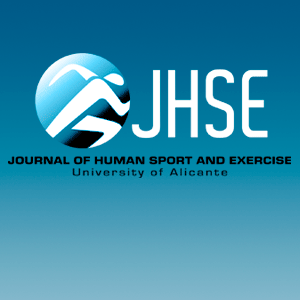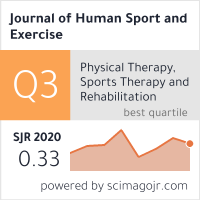Self-efficacy perception in elite water polo goalkeepers
DOI:
https://doi.org/10.14198/jhse.2021.162.06Keywords:
Sport psychology, Self-efficacy, High performance, Water poloAbstract
The sports in which there is the figure of goalkeeper, becomes relevant in order to obtain high performance, the perception of success that this participant is formed and that is configured as an expectation. Therefore, this study aims to analyse the association between perception of self-efficacy of two elite water polo goalkeepers and their coach and the observable performance in an international tournament. In order to measure the perception of behavioural success and their coach, it was used the Scale of achievement self-efficacy for water polo goalkeepers (Argudo, De la Vega, Tejero, & Ruiz, 2013). To measure the performance, were analysed all throwing`s received by the two goalkeepers in the XV Water polo World Championship. The results indicate that there are differences between the perception of the player, the coach and the observed behaviour, appreciating that the goalkeeper's perception of success is superior to what actually happens. While in the female case, player and coach perception is less than the observed behaviour.Downloads
References
Argudo, F. M., Alonso, J. I., Fuentes, F., & Ruiz, E. (2010). Polo Análisis v1.0 Directo. Registro computerizado para la evaluación táctica cuantitativa en tiempo real en waterpolo. En F. M. Argudo, S. Ibáñez, E. Ruiz & J. I. Alonso, Softwares aplicados al entrenamiento e investigación en el deporte (pp. 137-147). Sevilla: Wanceulen.
Argudo, F. M., De la Vega, R., Tejero, C. Mª., & Ruiz, R. (2013). Escala de autoeficacia de logro para porteros de waterpolo. Validación de contenido y traducción anglosajona. Revista Española de Educación Física y Deportes, 401, 125-136. https://doi.org/10.5672/apunts.2014-0983.es.(2015/4).122.02
Arruza, A., Sajoa, T., Gil, L., Arribas, S., Balagué, G., Cechinni, J. A., & Brustad, B. (2009). Understanding the relationship between perceived development of the competition plan and sport performance: mediating effects of self-efficacy and state depression. Perceptual and Motor Skills, 109(1), 304-314. https://doi.org/10.2466/pms.109.1.304-314
Arruza, J. A., Arribas, S., Otaegi, O., González, O., Irazusta, S., & Ruiz, L. M. (2011). Perception of competence, mood state and stress tolerance in young high performance athletes. Anales de Psicología, 27(2), 536-543.
Balaguer, I. (1998). Self-concept, physical activity and health among adolescents. Trabajo presentado en 24th International Congress of Applied Psychology, San Francisco.
Bandura, A. (1977) Self-efficacy: toward an unifying theory of behavioral change. Psychological Review, 84, 191-215. https://doi.org/10.1037/0033-295x.84.2.191
Bandura, A. (1997). Self-efficacy. New York: Freeman.
Beattie, S., Lief, D., Adamoulas, M., & Oliver, E. (2011). Investigating the possible negative effects of self-efficacy upon golf putting performance. Psychology of Sport and Exercise, 12, 434-441. https://doi.org/10.1016/j.psychsport.2011.02.004
Carroll, B. & Louidis, J. (2010). Children's perceived competence and enjoyment in physical education and physical activity outside school. European Physical Education Review, 7(1), 24-43. https://doi.org/10.1177/1356336x010071005
Cliff, N. (1993). Dominance statistics: ordinal analyses to answer ordinal questions. Psychological Bulletin, 114 (3), 494-509. https://doi.org/10.1037/0033-2909.114.3.494
De la Vega, R., Ruiz, R., Tejero, C. Mª., & Argudo, F. M. (2012). Escala de autoeficacia de lanzamiento en waterpolo. Trabajo presentado en XIII Congreso Nacional y I Foro del Mediterráneo de Psicología de la Actividad Física y el Deporte. Universidad de Murcia, España.
García-Naveira, A. (2018). Autoeficacia y rendimiento en jugadores de fútbol. Cuadernos de Psicología del Deporte, 2(18), 66-78.
González, A., Bermúdez, S. G., Martínez, I, & Chirosa, L. J. (2017). Eficacia de los porteros en los Juegos ODESUR y Campeonato Panamericano de Balonmano en 2014. Apunts. Educación física y deportes, 4(130), 95-105. https://doi.org/10.5672/apunts.2014-0983.es.(2017/4).130.08
Hellín, P., Moreno, J. A., & Rodríguez, P. L. (2006). Influencia social del género y de la percepción de competencia en la valoración de las clases de educación física. Revista Española de Educación Física y Deportes, 5, 37-49.
Hernández, J. M., Santacreu, J., & Rubio, V. (1999). Evaluación de la personalidad: una alternativa teórico- metodológica. Escritos de Psicología, 3, 20-28.
Kuiper, N., McDonald, M., & Derry, P. (1983). Parameters of a depressive self-schema. En J. Suls & A. Greenwald (Eds), Psychological perspectives on the self (pp. 191-217). Hillsdale, NJ: Erlbaum.
León, O. G., & Montero, I. (2003): Métodos de investigación en Psico¬logía y Educación (3ª edición). Madrid: McGraw-Hill.
Levy, A., Nicholls, A., & Polman, R. (2011). Pre-competitive confidence, coping, and subjective preformance in sport. Scandinavian Journal of Medicine & Science in Sport, 21(5), 721-729. https://doi.org/10.1111/j.1600-0838.2009.01075.x
Lozovina, M., Lozovina, V., & Pavièiæ, L. (2012). Morphological changes in elite male water polo players: Survey in 1980 and 2008. Acta Kinesiologica, 6(2), 85-90.
Montero, I. M. & León, O. G. (2007). A guide for naming research studies in Psychology. International Journal of clinical and Health psychology, 7(3), 847-862.
Mowlaie, M., Besharat, M. A., Pourbohlool, S., & Azizi, L. (2011). The mediation effects of self-confidence and sport self-efficacy on the relationship between dimensions of anger and anger control with sport performance. 2nd World Conference on Psychology, Counselling and Guidance-2011. Procedia social and Behavioral Sciences, 30.
Olmedilla, A., Ortega, E., Garcés. E., Abenza, L., Blas, A., & Laguna, M. (2015). Perfil psicológico de los jugadores profesionales de balonmano y diferencias entre puestos específicos. Revista Latinoamericana de Psicología, 47(3), 177-184. https://doi.org/10.1016/j.rlp.2015.06.005
Ruiz, L. M. (1995). Competencia Motriz. Elementos para comprender el aprendizaje motor en educación física escolar. Madrid: Gymnos.
Salkind, N. J. (1999). Métodos de investigación. México: Pearson Prentice Hall.
Thomas, O., Lane, A., & Kingston, K. (2011). Defining and contextualizing robust sport-confidence. Journal of Applied Sport Psychology, 23(2), 189-208. https://doi.org/10.1080/10413200.2011.559519
Trejo, A. & Planas A. (2018). Eficacia ofensiva en situaciones de desigualdad numérica en el balonmano femenino. Apunts. Educación Física y Deportes, 131(1), 95-107. https://doi.org/10.5672/apunts.2014-0983.es.(2018/1).131.07
Vancouver, J., Thompson, C., & Williams, A. (2001). The changing signs in the relationships between self-efficacy, personal goals and performance. Journal of Applied Psychology, 86, 605-620. https://doi.org/10.1037/0021-9010.86.4.605
Vancouver, J. B. & Tischner, E. C. (2004). The Effect of Feedback Sign on Task Performance Depends on Self Concept Discrepancies. Journal of Applied Psychology, 89, 1092-1098. https://doi.org/10.1037/0021-9010.89.6.1092
Vila, H., Ferragut, C., Argudo, F., Abraldes, J., Rodríguez, N., & Alacid, F. (2009). Relationship between anthropometric parameters and throwing velocity in water polo players. Journal of Human Sport and Exercise, 4(1), 57-68. https://doi.org/10.4100/jhse.2009.41.07
Downloads
Statistics
Published
How to Cite
Issue
Section
License
Copyright (c) 2018 Journal of Human Sport and Exercise

This work is licensed under a Creative Commons Attribution-NonCommercial-NoDerivatives 4.0 International License.
Each author warrants that his or her submission to the Work is original and that he or she has full power to enter into this agreement. Neither this Work nor a similar work has been published elsewhere in any language nor shall be submitted for publication elsewhere while under consideration by JHSE. Each author also accepts that the JHSE will not be held legally responsible for any claims of compensation.
Authors wishing to include figures or text passages that have already been published elsewhere are required to obtain permission from the copyright holder(s) and to include evidence that such permission has been granted when submitting their papers. Any material received without such evidence will be assumed to originate from the authors.
Please include at the end of the acknowledgements a declaration that the experiments comply with the current laws of the country in which they were performed. The editors reserve the right to reject manuscripts that do not comply with the abovementioned requirements. The author(s) will be held responsible for false statements or failure to fulfill the above-mentioned requirements.
This title is licensed under a Creative Commons Attribution-NonCommercial-NoDerivatives 4.0 International license (CC BY-NC-ND 4.0).
You are free to share, copy and redistribute the material in any medium or format. The licensor cannot revoke these freedoms as long as you follow the license terms under the following terms:
Attribution — You must give appropriate credit, provide a link to the license, and indicate if changes were made. You may do so in any reasonable manner, but not in any way that suggests the licensor endorses you or your use.
NonCommercial — You may not use the material for commercial purposes.
NoDerivatives — If you remix, transform, or build upon the material, you may not distribute the modified material.
No additional restrictions — You may not apply legal terms or technological measures that legally restrict others from doing anything the license permits.
Notices:
You do not have to comply with the license for elements of the material in the public domain or where your use is permitted by an applicable exception or limitation.
No warranties are given. The license may not give you all of the permissions necessary for your intended use. For example, other rights such as publicity, privacy, or moral rights may limit how you use the material.
Transfer of Copyright
In consideration of JHSE’s publication of the Work, the authors hereby transfer, assign, and otherwise convey all copyright ownership worldwide, in all languages, and in all forms of media now or hereafter known, including electronic media such as CD-ROM, Internet, and Intranet, to JHSE. If JHSE should decide for any reason not to publish an author’s submission to the Work, JHSE shall give prompt notice of its decision to the corresponding author, this agreement shall terminate, and neither the author nor JHSE shall be under any further liability or obligation.
Each author certifies that he or she has no commercial associations (e.g., consultancies, stock ownership, equity interest, patent/licensing arrangements, etc.) that might pose a conflict of interest in connection with the submitted article, except as disclosed on a separate attachment. All funding sources supporting the Work and all institutional or corporate affiliations of the authors are acknowledged in a footnote in the Work.
Each author certifies that his or her institution has approved the protocol for any investigation involving humans or animals and that all experimentation was conducted in conformity with ethical and humane principles of research.
Competing Interests
Biomedical journals typically require authors and reviewers to declare if they have any competing interests with regard to their research.
JHSE require authors to agree to Copyright Notice as part of the submission process.






